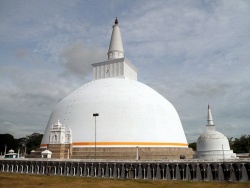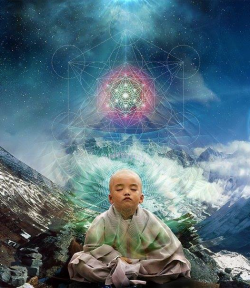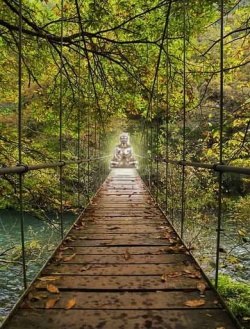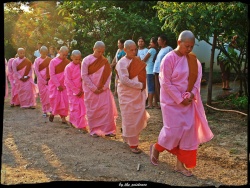Dzogchen, Madhyamika, Shentong & Rigpa
Im having a discussion with a Dzogchen practitioner and scholar about the nature of rigpa, which he says is not metaphysical yet it is still unconditioned. I brought up the rangtong-shentong debate (see Jackson below), because it seems that Dzogchen is still retaining the notion of an œunconditioned state that is not the same as the œconditional, conventional reality. I.e., the dichotomy of the two truths instead of their identity. Even the wikipedia entry suggests a relation of Dzogchen rigpa to shentong. Said practitioner quoted the Dalai Lama (below) as qualifying rigpa as avoiding the pitfalls of shentong and therefore valid. Yet when I read Batchelor on emptiness and the two truths (also below) I cannot reconcile how Dzogchen rigpa stays within the conditioned, codependent origination, yet is œoutside it in some œunconditioned state. Any help?
From Roger Jacksons review of The Great Debate on Emptiness:
Other-emptiness was declared to be the heart of a Great Madhyamaka philosophical system rooted in India and superior to the self-emptiness (rangtong) view of the Prasangika school regarded by Gelukpas (and others) as the acme of Buddhist thought. Although it originated with the Jonangpas, the otheremptiness view found adherents over the years within the other principal lineages of Tibet: the Nyingma, the Kagyu, and to a lesser extent, the Sakya. It is taught by certain masters of those traditions to this day.
The conflict between Rangtongpas and Shentongpas (as I will denote them) is perhaps the most significant philosophical debate in Tibetan history. The ground on which it was contested includes arguments about the Buddhas intent in teaching emptiness in multiple ways, the significance of discourse about buddhanature (or the œmatrix-of-one-gone-thus, as Hopkins translates it)1 and dharmakaya, the parameters of the two truths, and the sort of negation that emptiness is. To its participants, though, the debate is not mere scholastic speculation about how many nothings can fit on the non-head of a non-pin. Rather, it impinges directly on the great question of spiritual freedom: for Mahayana Buddhists, enlightenment is contingent on a direct realization of emptiness, and emptiness cannot be directly realized if ones philosophical understanding of it is incorrect. Thus, the stakes in the debate could not be higher.
From the wikipedia entry on Shentong.
Shentong (also, zhentong; Wylie: gzhen-stong), also sometimes called Yogacara Madhyamaka, is a philosophical sub-school found in Tibetan Buddhism whose followers hold that the nature of mind is œempty of other (i.e., empty of all qualities other than an inherent, ineffable nature), in contrast to the œRangtong view of the followers of Prasangika Madhyamaka, who hold that all phenomena are unequivocally empty of self-nature, without positing anything beyond that. According to Shentongpas, the emptiness of ultimate reality should not be characterized in the same way as the emptiness of apparent phenomena.
When speaking of the emptiness of mind’s ultimate nature, Shentongpas often use terms such as œluminous clarity, œluminous awareness, œthe clear light nature of mind, and so forth to characterize their experiences. Such language is often employed in Dzogchen expositions as well.
Stephen Batchelor on emptiness:
Emptiness is a confusing term. Although used as an abstract noun, it does not in any way denote an abstract thing or state. It is not something we œrealize in a moment of mystical insight that œbreaks through to a transcendent reality concealed behind yet mysteriously underpinning the empirical world. Nor do things œarise from emptiness and œdissolve back into it as though it were some kind of formless, cosmic stuff. These are just some of the ways emptiness has been appropriated as a metaphor of metaphysical and religious consolation.
Emptiness is a starkly unappetizing term used to under-cut yearnings for such consolation. Yet ironically it has been called into the service of such longings. Shunyata (emptiness) is rendered into English as œthe Void by translators who overlook the fact that the term is neither prefixed by a definite article (œthe) nor exalted with a capital letter, both of which are absent in classical Asian languages. From here it is only a hop, skip, and a jump to equating emptiness with such metaphysical notions as œthe Absolute, œthe Truth, or even œGod. The notion of emptiness falls prey to the very habit of mind it was intended to undermine.
Stephen Batchelor on the two truths (one might argue that Nagarjuna was trying to return an understanding of the two truths to the Buddha’s original meaning.):
œVery often, says Maurice Walshe in the introduction to his translation of the Long Discourses of the Buddha (Digha Nikaya), œthe Buddha talks in the Suttas in terms of conventional or relative truth (sammuti-sacca), according to which people and things exist just as they appear to the nave understanding. Elsewhere, however, when addressing and audience capable of appreciating his meaning, he speaks in terms of ultimate truth (paramattha-sacca).
This passage confirms a view familiar to all Buddhists, no matter what school to which they belong. It is technically known as the doctrine of the Two Truths, according to which reality is divided into two œlevels: the conventional and the ultimate, the relative and the absolute – or, as I translated it somewhere – the partial and the sublime.
It might come as a surprise, therefore – particularly after having just read the words of an eminent translator of the Buddha’s word – to learn that nowhere among the discourses (sutta) in the Pali canon does the Buddha use such terms. This famous distinction between œrelative and œabsolute truth is entirely alien to these early texts. One can certainly interpret his teaching through the lens of such an idea (which, if you read the passage carefully, is what Maurice Walshe does) but bear in mind that the distinction itself is one the Buddha never employed..
The notion of Two Truths goes entirely against the grain of what the Buddha taught. Siddhattha Gotama’s teaching is not founded on absolutes of any kind. He avoids the deeply ingrained assumption of much religious thought that reality is somehow split down the middle (God and Creation / Brahman and Maya / Nirvana and Samsara / Emptiness and Form). Ironically, of course, such divisions are blatantly dualistic – a position most Buddhists are supposed to be at pains to avoid.
In one of the most succinct accounts of his enlightenment, the Buddha speaks of awakening to œdependent origination, a truth that is œhard to see since it œgoes against the worldly stream. (Ariyapariyesana Sutta, Majjhima Nikaya 26, section 19). In modern parlance, his insight was counterintuitive. Why? because it went against two œstreams: our instinctive mental habit to split reality into two, and the outward expression of that habit in religious doctrines such as the Two Truths. The Buddha awakened to a glittering plurality of endlessly arising and vanishing phenomena. No God created it; no Mind underpins it; no Unconditioned lies somewhere outside it. Ethics, meditation and wisdom are not founded on some absolute truth, but grow out of a careful examination of what causes suffering and what brings it to an end. Enlightenment, for the Buddha, entailed simply paying attention to the phenomenal flux of your own empirical experience.
The doctrine of the Two Truths seems to have emerged fairly soon after the Buddha’s death. It is not a later Mahayana idea; for it was already taken for granted in the early Abhidhamma. I suspect that it was the first step in the progressive brahminization of Buddhism in India. The Two Truth doctrine is strikingly reminiscent of the Upanishadic teaching that the world of appearances is an illusion (maya) that separates us from the transcendent, absolute reality of God (brahman). But that, of course, was the worldview the Buddha sought to abandon. He wanted to replace it with another way of seeing things altogether: the radical contingency of all existence, devoid of any intrinsic self-essence or God.
Dalai Lama on shentong & dzogchen:
Question: Certain Nyingma masters have expounded shentong- emptiness of other-as the view of Dzogchen. Do you agree with them? Why is shentong such a controversial view among Tibetan Buddhist philosophers?
HHDL: If we read the writings of the great scholar Mipham, especially his commentary on the Sublime Continuum, we find that he explicitly mentions the importance of understanding the Dzogchen view, in which one is able to combine the teachings of emptiness, as expounded in the wisdom sashtras of the second turning of the wheel of Dharma, with the sashtras belonging to the third turning of the wheel of Dharma, particularly the Essence of Buddhahood Sutra. The understanding developed through a combination of the views expounded in both turnings of the wheel of Dharma will enable us to appreciate what in Dzogchen terminology are called: primordial purity, which is the main subject matter of the second turning, and spontaneous presence, which is the main subject matter of the third turning of the wheel of Dharma.
However, this does not mean that the emptiness spoken of in the second turning, that is in the wisdom sashtras, is exactly the same as what in Dzogchen terminology is called primordial purity But one thing which is clear is that without an understanding of emptiness as expounded in the wisdom sutras, and without taking that understanding as a basis, there is no way that you can understand primordial purity in the context of Dzogchen.
As for the question of whether spontaneous presence in Dzogchen is synonymous with what is called the tathagatagarbha- the essence of buddhahood or innate mind of clear light-in the third turning of the wheel of Dharma, especially in the Essence of Buddhahood Sutra, there do seem to be divergent views on that, even among Nyingma meditators and scholars.
One view is that, although there is a difference, the eventual reference for the innate mind of clear light spoken of in Maitreya’s Sublime Continuum or the Essence of Buddhahood Sashtra is definitely rigpa, or the spontaneous presence that is spoken of in Dzogchen. But that does not mean that the explicit mention of the two terms refers to the same thing. An example here is that in Yoga Tantra, especially in the tantra of Vairocanabhisarnbodhi, there is a mention of the rainbow body. Now although we cannot say that this rainbow body is totally synonymous with what is spoken of as the illusory body in Highest Yoga Tantra, yet eventually that reference to the rainbow body, if understood at its deepest level, will come down to the illusory body.
As I explained earlier, in the writings of the Nyingma masters Longchen Rabjam, the omniscient Jikme Lingpa, and Mipham, there may be mention of the term ˜emptiness of other’, but here the reference is mainly to the fundamental innate mind, that is, to rigpa. This innate mind is ˜empty of other’ in that it is devoid of circumstantial conceptual thought processes. Therefore these types of emptiness of other are totally different from the emptiness of other which was refuted by many Tibetan masters in the past.
There is a tradition of making a distinction between two different perspectives on the nature of emptiness: one is when emptiness is presented within a philosophical analysis of the ultimate reality of things, in which case it ought to be understood in terms of a non-affirming negative phenomena. On the other hand, when it is discussed from the point of view of experience, it should be understood more in terms of an affirming negation.
I think the reason for this statement is that when setting out your philosophical position and view of emptiness, you have to do so while taking into account the common viewpoints of sutra and tantra on the teaching of emptiness. But when speaking from an experiential point of view, you do so more from your understanding of emptiness in terms of the perspective of Highest Yoga Tantra.





